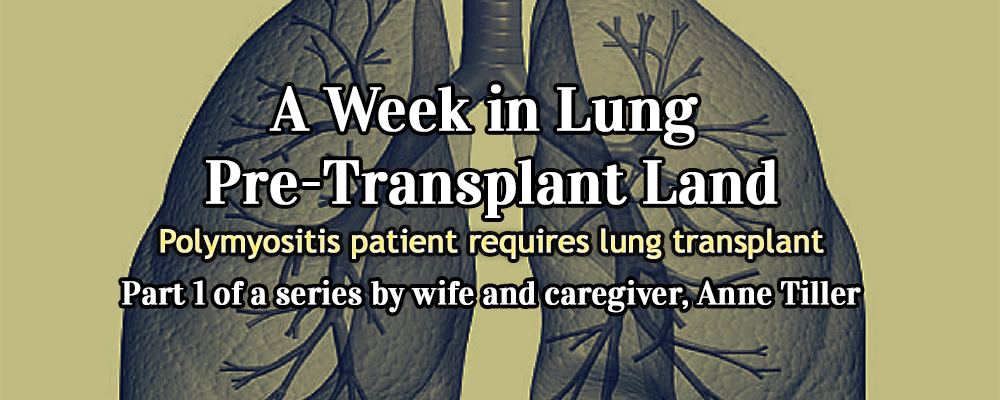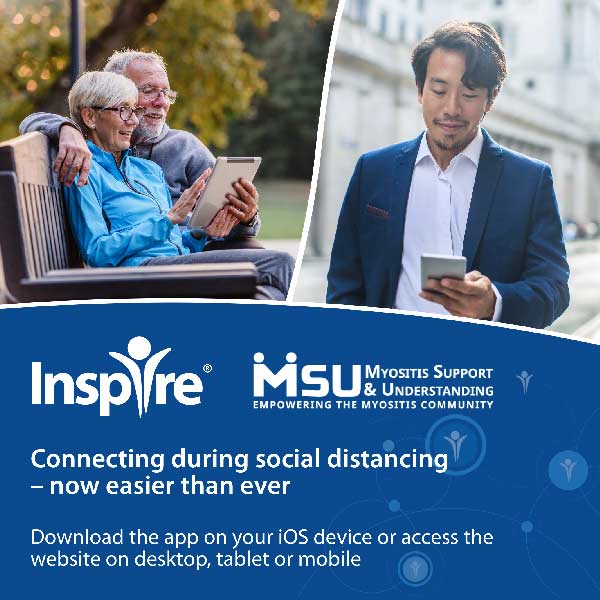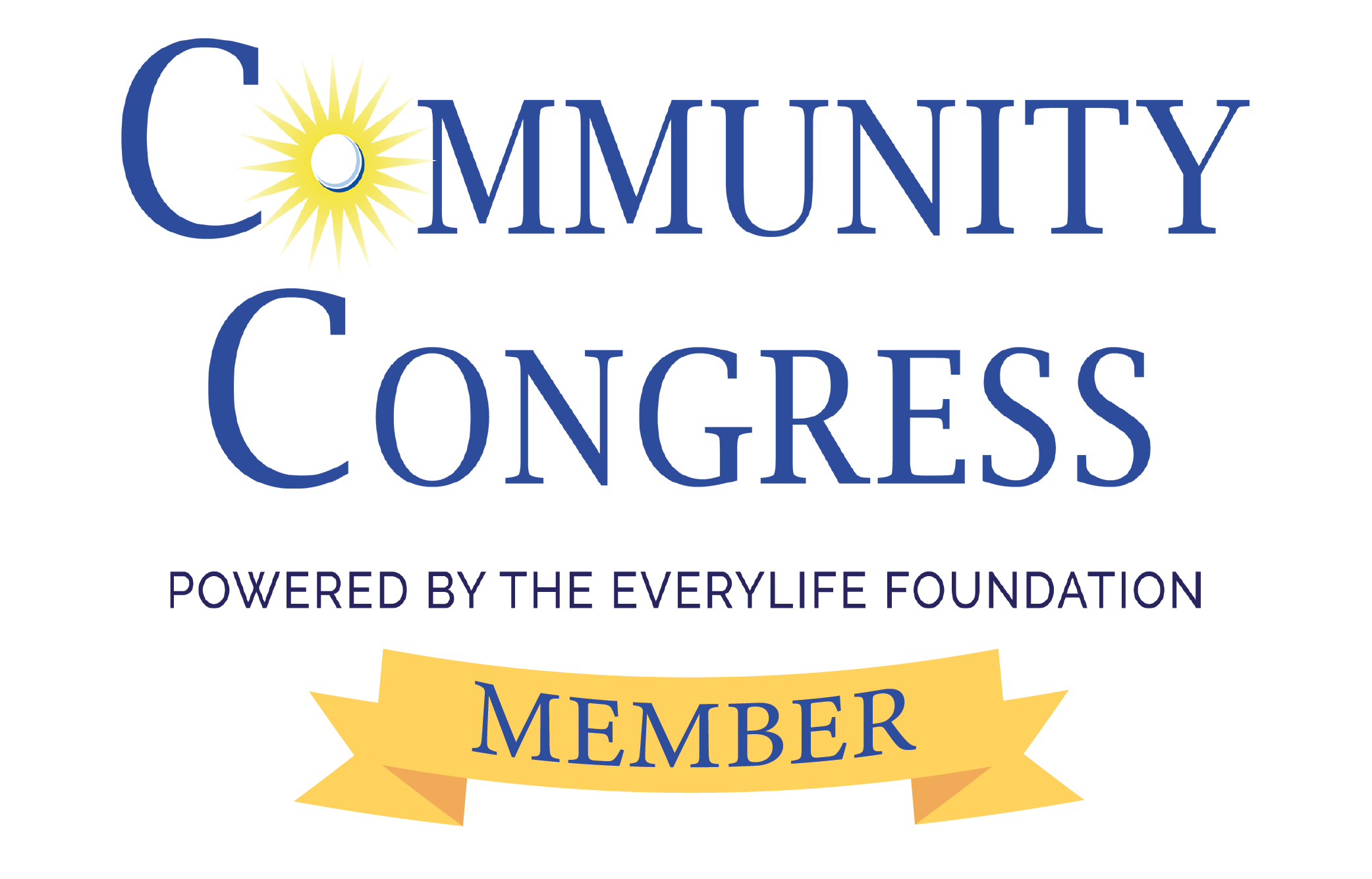A Week In Lung Pre-Transplant Evaluation Land
Part One of a series submitted by Anne Tiller
My husband has Polymyositis; known in general as Myositis and in his case, it also involves the lungs. He was diagnosed about seven years ago. While the Myositis has been fairly well controlled, the lung issue, Pulmonary Fibrosis, has been more difficult. He tested positive for the anti-jo antibody that often tells physicians that lung involvement with polymyositis could occur. Once the lungs are damaged, they do not recover. We were at a plateau for a long time with about 2/3 of lung function. This past year that began to change. When we finally accepted that things had progressed enough to consider going on the lung transplant list, things moved very quickly. We were contacted by a member of the transplant team for some basic information to start us down the road to what we hope will result in a double lung transplant.
The first thing to arrive was “The Packet.” This is a folder filled with documents, instructions, important phone numbers, and protocols. When you look at it the first time, it is intimidating. Take a deep breath and start with the first page. Most of it is straightforward stuff. However, read it all because there will be a quiz. Okay, not really, but this information will give you a great foundation and will help to answer a lot of questions and give you a basis to form others.
There are a number of websites that talk about transplants. Please stick to the respectable ones such as Johns Hopkins, Cleveland Clinic, Mayo Clinic, and University of Pittsburgh Medical Center (UPMC). Avoid sites that simply allow people to tell their stories. You want to know what is going to happen when you go in. Research and educate yourself, but don’t terrify yourself with uncheckable tales. There are more than enough things to worry about in the transplant process without adding useless fears.
Speaking strictly from our own experience at UPMC, the transplant team is excellent and filled with knowledgeable, approachable professionals.
By the time you get the packet you will probably already have an orientation date. Orientation is a class where you get to find out how the evaluation process works, what needs to happen before your loved one can be put on the list, and made “active,” and to meet with both transplant professionals and survivors. This is also where they explain the procedure; the nuts and bolts of the actual surgery, where the organs come from, how they get there, issues of compatibility, and expectations of the patient and caregiver.
They also talk about life post-transplant; the drug regime the patient will have to follow for the rest of the their life, the dangers of rejection and how these can be managed. For us it actually means fewer and less medication than what we are on now, with the chance of a much-improved quality of life.
They do not focus on, but do mention, the fact that some patients do not make it, but that possibility is already there. An 85% success rate after the first year means that 15% of patients do not make it. While chances are in your favor, talk about and plan for this possibility.
 This is a great place to ask questions. Listen carefully. This is also where you may feel overwhelmed by paperwork. You will get another packet with the patient’s name on it. This is filled with forms and more information. Having as many of the forms in the original packet completed ahead of time will save time and cut down on confusion.
This is a great place to ask questions. Listen carefully. This is also where you may feel overwhelmed by paperwork. You will get another packet with the patient’s name on it. This is filled with forms and more information. Having as many of the forms in the original packet completed ahead of time will save time and cut down on confusion.
The coordinator giving the orientation is very patient. They know how overwhelming the decision and the paperwork can be. One of the things they stress is that you can stop the process at any time before transplant if you feel you are not ready, and restart it when you are more comfortable. This was a relief and helped us to feel a little more in control of the roller coaster.
Another thing, don’t lie about anything. The battery of tests will turn up everything.
After orientation, you may be sent home (or to your temporary digs) or you may begin testing. We got sent home with tests to begin the next day.
We are up for a double lung transplant so Mike got to start off with the dreaded PFT (Pulmonary Function Test). Then we moved on to a round robin of people we will be working with during and after the transplant: Nutritionist, Pharmacist, Surgeon, Financial Advisor, and our Coordinator. Your coordinator will be your go-to person before, during, and after the transplant. This is the person who gets to juggle all the tests, appointments, surgery, and questions. Make nice. This person is your lifeline.
Next you will meet with a social worker, a behavioral health nurse, and for us, a transplant pulmonologist. Take notes if you can. Write down questions. At the very least, make sure to get their business cards and keep them in a safe place in case you think of something later.
There will be blood tests. In Mike’s case, since he is part of a few studies, they took 24 vials. It’s not that much really but I thought this post needed a little more drama. There will also be urine and either fecal tests or a colonoscopy. Mike also had to do a barium swallow test and a Sniff test or Fluoroscopy. The Sniff test consists of spraying a chemical into the lung and see how much of it gets exhaled. It tests the diaphragm.
The health of the heart is a big part of transplant evaluation. They have to make sure the ticker is strong enough to carry the patient through surgery. Mike had a six-minute walk (lungs and heart), Desaturation tests, X-Rays, CT scan, Echocardiogram and most likely a heart catheterization. For Mike, the worst is the heart catheterization. He hates them but that is strictly his personal issue as they are standard procedure. It does take most of a day between checking in, the procedure, and recovery. After all this I was kind of hoping he would glow in the dark because that would be kind of cool! But he didn’t.
Our biggest shock was finding out that Mike has problems with his esophagus. This means a feeding tube, post op. The length of time will depend on how well he heals as well as the danger of aspiration, and could be two weeks to 3 months. For a man who loves to cook and eat, this was a hard thing to swallow (insert groans here). We took a moment to digest this (I have a million of ‘em), but he decided it was not enough to reconsider the surgery. The reason for the feeding tube is to prevent aspiration into the new lungs which could cause a rejection reaction. One more hurdle, and one more potentially dangerous thing to deal with.
Now, to reassure you, a rejection reaction does not mean total rejection of the organ(s). It can, and will be treated. While it is not in any way desirable, it is not the end of the world either. It is actually a quite common occurrence. Trust your team, they know what they are doing.
For those of you who are thinking, “transplant is still a long way off,” don’t kid yourself. Mike went from functioning semi-normally to having trouble walking down a hallway in a matter of weeks due to an inability to breathe. GET YOUR THINGS IN ORDER. We did not and we are still scrambling, and we are seven years into this Polymyositis diagnosis. We should have known better.
Make sure you have insurance. Set up a help network. Put as much of a safety net in place as possible before you need it. Check into FMLA, medical sabbatical, short term and long term disability, Medicare, Medicaid etc. Think now about who your primary and secondary caregivers will be. Ask these people ahead of time. Be selective. Think with your head, not your heart. Can this person really take over for you in an emergency? Can they drive? Can they afford to help? The secondary caregiver would benefit from attending an orientation session. Ask your coordinator to set it up.
As primary caregiver, be prepared to take a week off to attend all the tests and meetings with your loved one. When you get to this point, you should have a network in place. Do not try to do this alone. Going through the transplant with your loved one may be the hardest thing you will ever have to do. You will need help. Family, friends, strangers, support groups, blogs, your transplant team. Caregivers burn out! I know you have heard this a hundred times, but please, please, please, take care of yourself.
Right now we are in the waiting stage. We are finishing up the remaining tests and submitting them to the transplant team. I will write more in the coming weeks.
Remember that this is just our experience. Everyone’s is different. Every hospital’s protocol is different. My aim is to take some of the fear out of this process and to help others understand how pre-transplant works.
If you have any questions, please leave comments below and I will try to answer them.
TIPS FOR TRANSPLANT EVALUATION WEEK
- Bring something to occupy your time.
- Remember everything has to be carried with you from place to place. A rolling bag is a good idea.
- Bring snacks and drinks. You may be there longer than anticipated.
- Bring a change of clothing in case you need it (Mike could have used a dry shirt).
- Don’t be afraid to ask if you need something.
- Talk to people. They may have answers or questions you haven’t thought of.
- Valet parking is awesome. Check with information to see if you can get a discount if you have to park all week.
- Try to be patient. Both of you are having a long week.
- A sense of humor, even dark humor, is helpful.
- Treat your team well. They will be your lifeline.
Stay tuned for the next installment of this series.
Tags: caregivers organ transplant









